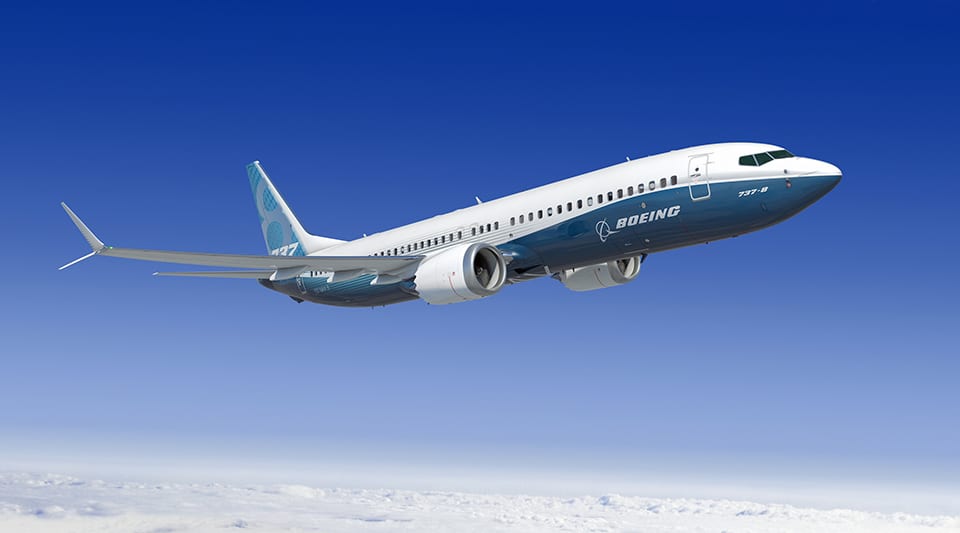
Boeing said that it is aiming to return the 737 MAX to service by the middle of this year. Photo: Boeing
Boeing is targeting a return to service of the 737 MAX by the middle of this year, according to CEO David Calhoun, who took the helm of the company on Jan. 13.
“As we mentioned last week, we’re currently estimating that the un-grounding of the 737 MAX will begin mid-2020,” Calhoun said on Jan. 29 during his first earnings call with investors. “This estimate is informed by our experience to date with the certification process. It is subject to our ongoing attempts to address known schedule risks and further developments that may arise in connection with the certification process. It also accounts for the rigorous scrutiny that regulatory authorities are rightly applying at every step of their review of the 737 MAX’s flight control system and the Joint Operations Evaluation Board process, which determines pilot training requirements.”
The board comprises representatives from the FAA’s Flight Standardization Board, Europe, Brazil and Canada.
Calhoun said that “it is important to emphasize that this [return to service] estimate should not be interpreted as an attempt to influence or interfere with the FAA and other regulators’ absolute authority to determine the timing and conditions of return to service.”
“Very simply, accurate financial reporting requires we provide our latest and most informed schedule,” he said. “Similarly, our supply chain, in the name of transparency, requires a schedule to perform up to its standard.”
The Boeing Power Point presentation to investors on Jan. 29 indicated that the company expects to incur $18.6 billion in costs related to 737 MAX, including $6.3 billion in production costs in fiscal 2019, $8.3 billion in payments to airlines for non-delivery of the jets, and a $4 billion hit to earnings “to be expensed, as incurred, primarily in 2020” which was an expense for “abnormal production costs” related to retaining suppliers and shifting Boeing 737 MAX assembly line workers in Renton, Wash. elsewhere in the company, while 737 MAX production is at a halt.

Boeing 737 MAX cockpit. Photo: Boeing
On Jan. 29, Boeing announced fiscal 2019 revenues of $76.6 billion–$24.5 billion less than last year–and a loss per share of $3.47 in fiscal 2019, compared to earnings per share of $16.01 last year.
Boeing suspended 737 MAX production this month to prioritize the delivery of 400 newly manufactured aircraft in storage and allow time for civil aviation authorities to approve updates that will clear its return to service.
Aviation regulators grounded the 737 MAX in March last year after the crashes of Ethiopian Airlines and Lion Air flights in October, 2018 and March, 2019 killed 346 passengers and crew.

David L. Calhoun took over as CEO of Boeing Jan. 13, 2020. Photo: Boeing
A decision to stop production of the MAX comes as Boeing continues to await approval from civil aviation authorities on software updates designed to fix the maneuvering characteristics augmentation system (MCAS) system that contributed to the two crashes.
During the Jan. 29 Boeing earnings call, in response to a question from Ronald Epstein, a Bank of America senior equity analyst, on how to change the culture at Boeing, Calhoun said that, while Boeing leaders need to listen better to safety concerns raised by Boeing engineers and others, Boeing’s culture was not responsible for the 737 MAX crashes.
“First of all, let’s go back to what happened,” he said. “The MCAS design failed to deal with a boundary condition in an environment we should have known something about. The regulators made the same mistake. There are engineering disciplines that you can and should apply to that question that I think you can get fixed relatively quickly. I don’t think culture contributed to that miss. I think, simply, discipline did.”
Last October, former Boeing CEO Dennis Muilenburg, said that Boeing expected the grounding to be lifted by the end of 2019. Later that same month, Muilenburg told Congress that pilots would have the ability to override the 737 MAX MCAS and that a dual sensor feed would replace the previous version of MCAS that relied upon a single angle of attack (AOA) sensor for providing information to the aircraft’s flight control computers.
Boeing ousted Muilenburg last month amid the 737 MAX crisis at the company.